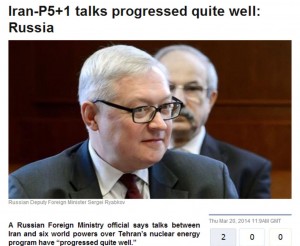See the update below, as of about 2:45 pm, the Times has changed the wording of the erroneous paragraph without adding a note of the correction. Oops. I got off on the wrong paragraph when I checked back. See the comment from Tony Papert below.
For someone who has written on a range of technical issues for many years, the error committed last night by David Sanger could not be worse nor come at a worse time for the important events he is attempting to cover. In an article put up last night on the New York Times website and apparently carried on page A1 of today’s print edition, Sanger and the Times have garbled a key point at the heart of the negotiations between Iran and the P5+1 group of nations as they near the critical November 24 deadline for achieving a full agreement on the heels of last year’s interim agreement.
The article ostensibly was to announce a major breakthrough in the negotiations, although Gareth Porter had worked out the details of the progress last week. Here is what Porter deduced:
The key to the new approach is Iran’s willingness to send both its existing stockpile of low enriched uranium (LEU) as well as newly enriched uranium to Russia for conversion into fuel for power plants for an agreed period of years.
In the first official indication of the new turn in the negotiations, Iranian Foreign Ministry spokesperson Marzieh Afkham acknowledged in a briefing for the Iranian press Oct. 22 that new proposals combining a limit on centrifuges and the transfer of Iran’s LEU stockpile to Russia were under discussion in the nuclear negotiations.
The briefing was translated by BBC’s monitoring service but not reported in the Western press.
Undersecretary of State Wendy Sherman, who heads the U.S. delegation to the talks, has not referred publicly to the compromise approach, but she appeared to be hinting at it when she said on Oct. 25 that the two sides had “made impressive progress on issues that originally seemed intractable.”
As Porter goes on to explain, such an arrangement would allow Iran to maintain a large number of centrifuges continuing to enrich uranium, but because there would be no stockpile of low enriched uranium (LEU), the “breakout time” (time required to highly enrich enough uranium for a nuclear weapon) would remain at about a year. By having Russia convert the LEU to fuel rods for Iran’s nuclear power plant, that LEU would be removed from any easy pathway to a weapon. This would provide Iran the “win” of maintaining its present level of around 10,000 operational centrifuges but give the P5+1 its goal of a longer breakout time. The key here is that unlike a proposal in 2005 where Russia would take over enrichment for Iran, this new proposal would allow Iran to continue its enrichment program while shipping virtually all of of its LEU to Russia for conversion to fuel rods.
Sanger appears to start off on the right track with his article:
Iran has tentatively agreed to ship much of its huge stockpile of uranium to Russia if it reaches a broader nuclear deal with the West, according to officials and diplomats involved in the negotiations, potentially a major breakthrough in talks that have until now been deadlocked.
Under the proposed agreement, the Russians would convert the uranium into specialized fuel rods for the Bushehr nuclear power plant, Iran’s only commercial reactor. Once the uranium is converted into fuel rods, it is extremely difficult to use them to make a nuclear weapon. That could go a long way toward alleviating Western concerns about Iran’s stockpile, though the agreement would not cut off every pathway that Tehran could take to obtain a nuclear weapon.
But about halfway through the article, Sanger displays a shocking ignorance of the real points of recent negotiations and somehow comes to the conclusion that Russia would be taking over enrichment for Iran rather than converting LEU into fuel rods:
For Russia, the incentives for a deal are both financial and political. It would be paid handsomely for enriching Iran’s uranium, continuing the monopoly it has in providing the Iranians with a commercial reactor, and putting it in a good position to build the new nuclear power reactors that Iran has said it intends to construct in the future. And it also places President Vladimir V. Putin at the center of negotiations that may well determine the future of the Middle East, a position he is eager to occupy.
Somehow, Sanger and his New York Times editors and fact-checkers are stuck in 2005, suggesting that Iran would negotiate away its entire enrichment program. Such a drastic move would never be contemplated by Iran today and we are left to wonder whether this language found its way into the Times article through mere incompetence or more nefarious motives meant to disrupt any possible deal by providing false information to hardliners in Iran.
At the time of this writing (just before 9 am on November 4), the Times still has not added any correction or clarification to the article, despite the error being pointed out on Twitter just after 10:30 pm last night (be sure to read the ensuing Twitter conversation where Laura Rozen and Cheryl Rofer work out the nature of the error).
Update: And now, around 2:45 in the afternoon, I see that the Times has changed the erroneous paragraph. So far, I don’t see a note that a correction has been made. Here is the edited paragraph:
Russia’s calculus is also complex. It stands to gain financially from the deal, but it also has an incentive to see the nuclear standoff between Iran and the rest of the world continue, because an embargo keeps Iranian oil off the market. With oil prices falling, a flood of exports from Iran could further depress prices.
Will they ever get around to adding a note? I’ll keep an eye out. Well dang, this is embarrassing. I went to the wrong paragraph when I looked back. The article is still unchanged. Thanks to Tony Papert in comments for catching my bone-headedness.
 Kaspersky Lab reported this morning a next-generation version of Duqu malware infected the information security company’s network.
Kaspersky Lab reported this morning a next-generation version of Duqu malware infected the information security company’s network.
